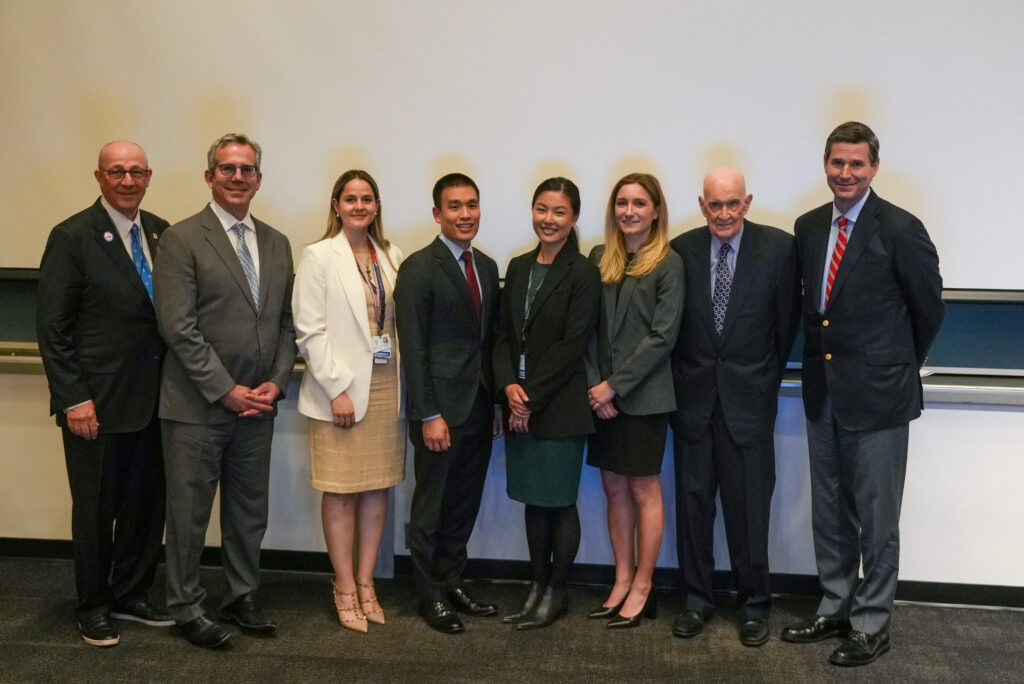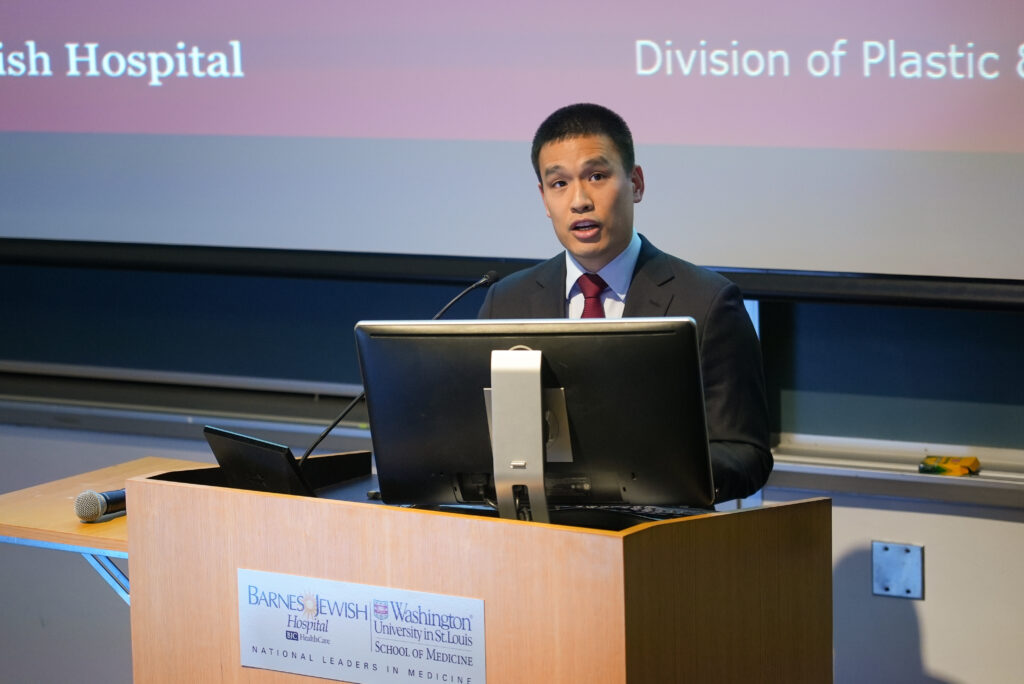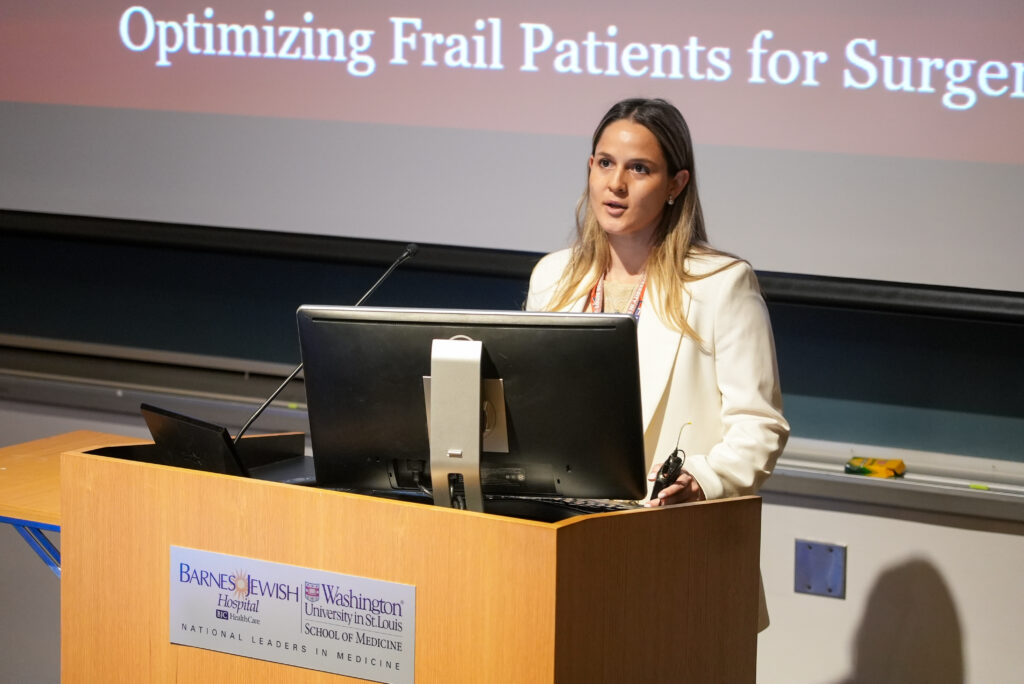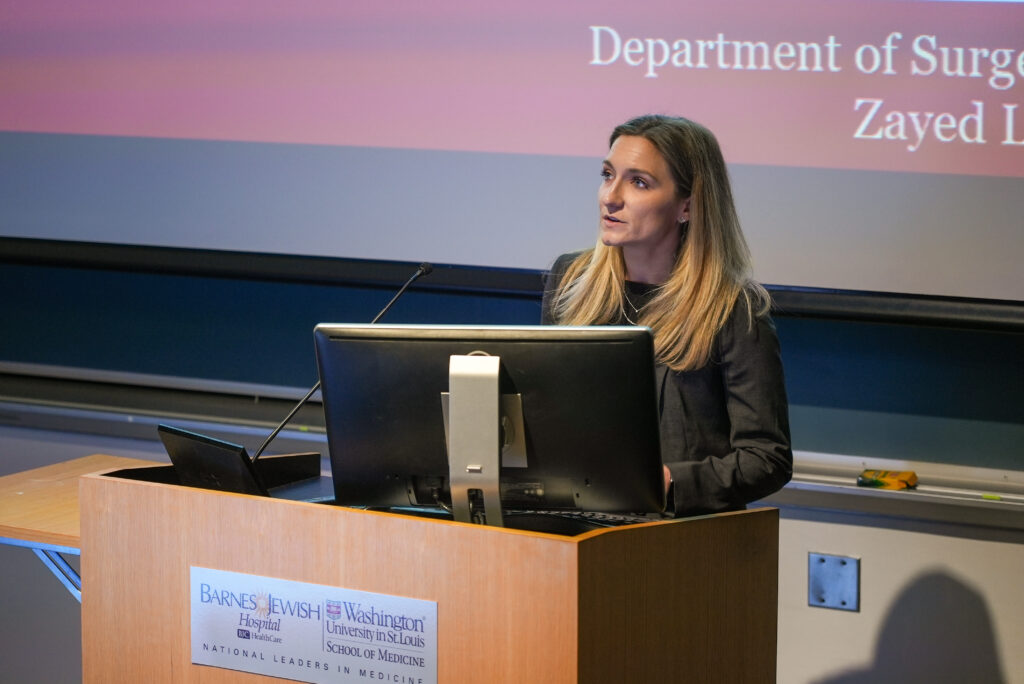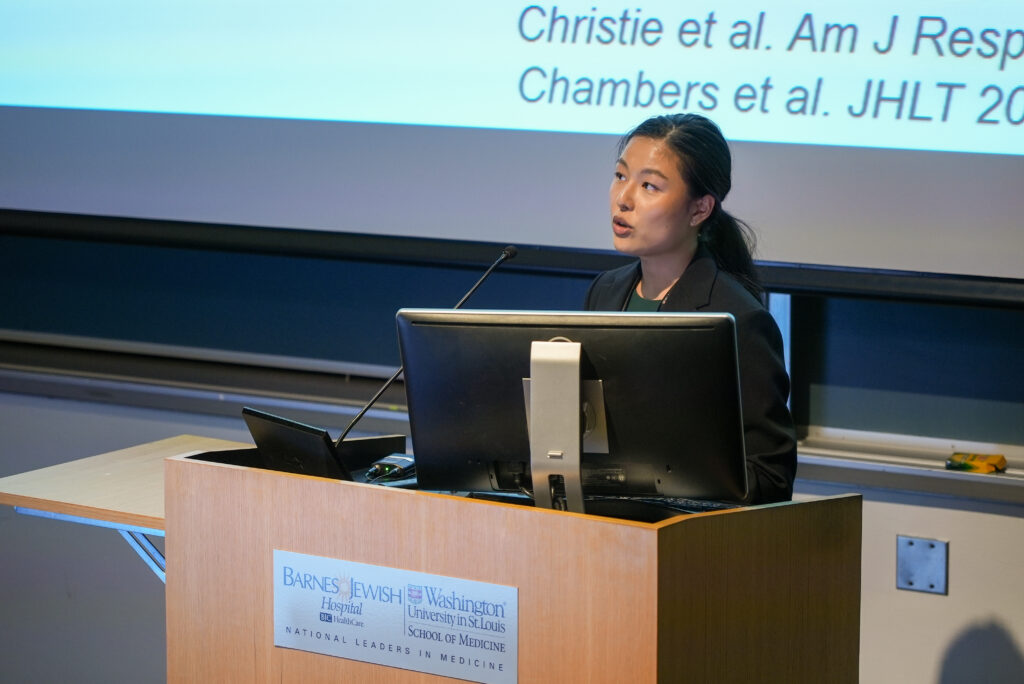On Tuesday, April 4, 2023, Washington University faculty, staff, residents and guests gathered to watch four resident finalists compete and present their research at the 22nd annual Samuel A. Wells, Jr., Resident Research Day Competition. David Chi, MD, Heidy Cos, MD, Sophia Roberts, MD, and Louisa Bai, MD, were selected as finalists for their exceptional research in two categories: Clinical, Outcomes, Innovation and Education Research, and Basic and Translational Research. Following the presentations, each of which incorporated a Q&A with invited discussants, faculty voted to select one winner from each of these two categories. Dr. Wells himself, former department of surgery chair, was in attendance for this year’s competition alongside visiting professor Geoffrey C. Gurtner, MD, chair of the department of surgery and professor of biomedical engineering at University of Arizona College of Medicine.
Clinical, Outcomes, Innovation and Education Research
This year’s competition opened with outstanding presentations in the Clinical, Outcomes, Innovation and Education Research category by Chi and Cos.
Chi’s presentation, entitled “Escalating Surgical Treatment for Left Ventricular Assist Device (LVAD) Infections is Associated with Decreased Expected Mortality: A Clinical Risk Prediction Score,” discussed multidisciplinary and cross-departmental research from the program of Ida Fox, MD, on exploring strategies to identify risk of complications in LVAD patients to properly address treatment improve long-term outcomes. Chi discussed methods of identifying patients’ risk for developing LVAD infection and how early risk-identification can get patients preemptively triaged for procedures such as flap reconstruction in the case of an infection wherein medical management alone would prove unsuccessful. Using previously unidentified risk factors, Chi described a study which ultimately improved patient outcomes and decreased mortality in cases where infection risk was identified early on. Patients were then referred to appropriate outlets – often including multidisciplinary teams involving plastic surgeons alongside cardiothoracic teams – and triaged for surgical procedures such as flap reconstruction early on rather than relying on typically prescribed medical management. Chi concluded that utilizing a clinical risk tool for identifying patients at high risk of developing LVAD infection can guide physicians down more optimal avenues for treatment, including surgery, surgical debridement and potential flap reconstruction, to help improve expected mortality in high-risk patients.
Cos, one of last year’s finalists and this year’s Clinical, Outcomes, Innovation and Education Research category winner, presented research from the program of Dominic Sanford, MD, MPHS, in a presentation entitled “Prehabilitation Reduces Postoperative Mortality and Need for Non-Home Discharge in High-Risk Surgical Patients.” This research addressed the potential of the Surgical Preparation and Readiness (SPAR) Program in improving postoperative outcomes for higher-risk patients. While the concept of prehabilitiation prior to surgery is generally accepted as a way to improve post-operative outcomes, Cos’ research on the initiation of the SPAR program proved hopeful that a streamlined program can decrease patients’ length of stay in the hospital following surgery, non-home discharge, and even 30-day mortality. Cos explained that the SPAR program provides structure for patients before surgery and aims to improve physical fitness, respiratory health, nutrition, and mental health and preparedness through means of counseling and progress tracking across these different health aspects. Results indicated that, following adherence to the program, participants’ overall health as well as their post-operative outcomes were improved compared to similar patients not involved in the program. SPAR, Cos reported, also prevented one death in every 24 patients enrolled – data previously unseen in other instances of prehabilitation research. Cos’ research concluded that, while SPAR patients were higher-risk at the outset of the program, the program provides a “safe and feasible” method to reduce extensive post-operative hospital stays and mortality even in at-risk patients.
Read more: SPAR Receives 2022 QUEST Award
Cos’ research and presentation received high praise from various faculty during questions following, including discussant Ivan Kangrga, MD, PhD, Director of Clinical Anesthesiology at Washington University. “I appreciate the holistic approach where we think about psychological resilience. This was one of the key factors that I think made this so successful,” Kangraga said. “Prehabilitiation has great potential, but modest evidence. Studies like this have the potential to fill in that evidence gap as it develops. Congratulations, I think that’s quite impressive.”
Basic and Translational Research
Roberts and Bai then kicked off the second half of the competition by presenting their impressive findings in the Basic and Translational Research category.
Roberts, presenting research from the lab of Mohamed Zayed, MD, PhD, MBA, detailed the development and early implementation of a newly designed islet transplantation device in her presentation, entitled “A Novel Arteriovenous Graft Platform for Pancreatic Islet Xenotransplantation.” Roberts detailed that this multilayered device, called the AVGRx, was designed with a porous membrane in its central treatment zone to address two main problems in pancreatic islet transplantation for the possible long-term treatment of insulin-dependent diabetes: poor transplanted islet oxygenation and risk of rejection. The device was designed to be safely implanted in direct contact with the blood stream and the membrane was developed to allow insulin to penetrate the device but to prevent the immune system from attacking. Roberts described a study in which the AVGRx device, containing human islet cells, was implanted into pigs. Roberts reported promising results: the islets proved viable post-insertion, the device was patent in 100% of porcine hosts. Most remarkably, the AGVRx device proved it could support human insulin in a pig – entirely without the use of immunosuppression. In the future, Roberts concluded, the AVGRx could provide foundation for a product which could assist in long-term treatment for insulin-dependent diabetes in humans.
Bai’s winning presentation, entitled “B Cells Mediate Lung Ischemia Reperfusion Injury via Synergetic BCR-TLR4 Signaling” delved into research from the lab of Ruben Nava, MD, which sought to understand factors leading to decreased lung function following lung transplantation. Bai noted in the introduction to her presentation that lung transplant patients have notably higher five-year mortality rates in comparison to other organ transplant patients. To begin addressing this problem, Bai described a series of experiments she and her team conducted utilizing adoptive B cell transfer and hilar clamping in mice. These experiments proved that B cells contribute to classical monocyte recruitment in the lungs following lung ischemia. The early experiments in mice compared classical monocyte recruitment and neutrophil extravasation in mice who naturally produce B cells, B cell deficient mice, and naturally B cell deficient mice who received an injection of adoptively transferred B cells. The team discovered that only the B cell deficient mice who had not received the transfer had lower levels of classical monocytes following ischemia and reperfusion. Once this correlation was proved, Bai described how her team then tackled the more nuanced question regarding what types of B cells and genes specifically contribute to this process of neutrophil extravasation and lung injury. She described that, after similarly structured experiments on mice to single out B cells with both CCL7 and CCL2 genes, the team discovered that Trif-dependent CCL7 specifically contributed to classical monocyte recruitment in the lung following transplant, ultimately decreasing lung function. Bai concluded that these discoveries open exciting possibilities for B cell-targeting therapies for patients following lung transplantation in the hopes of preventing lung ischemia reperfusion injury and improving long-term outcomes overall.
During the round of questions following Bai’s presentation, Ramsey Hachem, MD, medical program Director of the Washington University Lung Transplant Program, praised Bai’s work. “This is a great showcase of research going on in this department,” Hachem said. “Terrific presentation, wonderful results, wonderful delivery of the data. I congratulate you and Dr. Nava on this work.”
The Wells Resident Research Day Competition provides an opportunity to showcase the incredible work done by residents and faculty every day at the School of Medicine and pays homage to the great contributions by Dr. Wells still felt throughout the institution today. The Department of Surgery congratulates Cos and Bai for their outstanding presentations and all four finalists for their impressive research and dedication.
Samuel A. Wells, Jr., MD, served as the Chair of Washington University’s Department of Surgery from 1981 to 1997. He is well known at Washington University as a key contributor to the advancement of the surgical education program and a champion for uplifting the School of Medicine as a world-class research institution. Wells is a highly decorated surgeon and has received a number of awards for his work, including the Jean Vicks Inspiration award for his contributions to thyroid cancer research and treatment and the Medallion for Scientific Achievement – the highest honor bestowed by the American Surgical Association. His legacy is carried by the brilliant and dedicated researchers and physicians within the Department of Surgery today as they continue to advance the field of academic medicine into the future.
